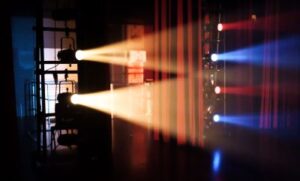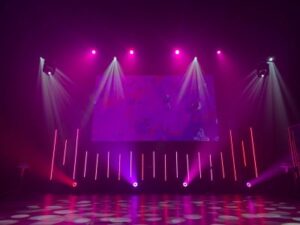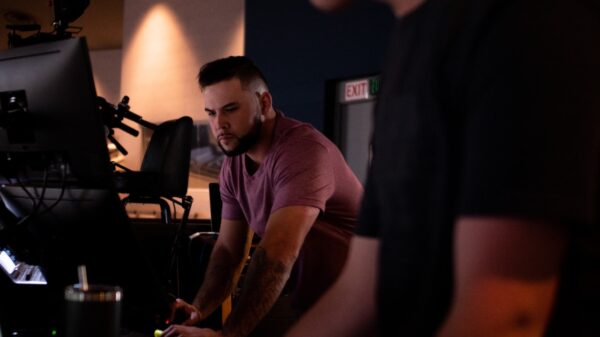The Best Stage Lighting for Church Service
Stage lighting often goes unnoticed when you’re in the audience, but without the proper lighting, the overall tone of what is happening on stage can be changed drastically. After many test runs and rehearsals throughout the years, I have nailed down what looks the most appealing during our church service.
So, what is the best tip for the perfect stage lighting during service? Ambient lighting is one of the most important tips for perfect stage lighting. Ambient light is the light that surrounds your subject and helps to create a natural atmosphere. This can be done by either using a softbox or simply bouncing white light off the walls around your stage. This will give a soft effect and draw the audience’s eye to the stage, rather than having a bright white light shining in their eyes.
Many people who are in a church band often come from a background of playing in other groups and can be used to having a light right in front of them, covering their face, and lighting up the audience. Sometimes we play too much with the house lights turned down and forget to use stage lights or to supplement with ambient lighting.

Achieve Great Lighting Every Sunday
The best lighting is achieved when the light crew and band have collaborated on what song’s are going to play, and what tone you want to come across. This can be as simple as “let’s have a dark moody feel for this song” or as complex as “turn down the stage lights and up the house lights, we are going to play an up-tempo version of this hymn”.
Here are some tips for success:
1. Ambient Lighting
As previously mentioned, this type of lighting is key to creating a natural atmosphere on stage. It should be used as the main light source whenever possible.
2. White Balance
Make sure your white balance is set correctly on your camera. This can be done by using either an automatic or manual white balance setting.
3. Backlight
Backlight can be achieved by placing a stage light behind your subject. Make sure the backlight you use is dimmed to avoid shining directly into the audience’s faces.
4. Accent Lighting
Use accent lighting to brighten certain parts of your subject, such as their hands or face if they are playing an instrument. This helps further define your subject and separates them from the background.
5. Side Lighting
Side lighting can be used to create shadows on your subject’s face and can give a more three-dimensional look to their features.
6. Color Correction
If you are using gels on your stage lights, make sure to use color correction filters on your camera to avoid color distortion.
7. Framing Your Subject
Framing your subject can be done by using stage lights to frame them with light or by using light to create a halo around them. This will help to focus the audience’s attention on your subject.

How Do You Assemble Church Lights?
Churches often have stage lighting that is used in different ways. Sometimes stage lights are simply turned on throughout the service to light up the stage, while other churches use stage lights in a variety of creative ways.
No matter how your church uses stage lighting, you will need to put together your stage lights before services so that they can be ready for use. Follow these steps to assemble stage lighting for a church service.
Step 1
Read over what type of stage lighting equipment has been purchased and which items have to be assembled.
Step 2
Place all purchased stage lighting equipment out onto a table or floor space where everything can be laid out comfortably and easily accessible.
Step 3
Plug flashlights into electrical outlets if using flashlight-style stage lights.
Step 4
Refer to the stage lighting equipment diagram that is usually included with stage light purchases. This will help in assembling stage lights correctly.
Step 5
Begin by assembling the stage light stand, if it is a collapsible type stand. Carefully unfold the legs of the stand and spread them out evenly so the stand will be stable.
Step 6
Place the stage light “head” onto the top of the stage light stand. Be sure that the pins on the top of the stage light head fit securely into the holes on the top of the stage light stand. If they do not fit securely, you may need to adjust them or purchase a different style of stage light stand.
Step 7
Secure each stage light by tightening its thumbscrews.
Step 8
Plug stage light cords into electrical outlets, if necessary.
Step 9
Mount stage lighting equipment if it has been purchased already assembled and needs to be mounted at stage level for use. If the stage lights will not be mounted on stage level, then simply place each stage light wherever you feel is best for your purpose and desired look of stage lighting.
Step 10
Turn on stage lights and test them to make sure they work. If they do not, check all connections and try again. Once stage lights are working as desired, turn off the electricity to the stage lights by turning off all of their switches or unplugging their power source (if using flashlight-style stage lights). You can now begin preparing church services.
Step 11
If stage lights are not needed during the week or you will not be using them, remember to turn off all stage light switches and unplug stage light cords (if using flashlight-style stage lights) when not in use. This will help keep stage lights in good condition for longer life spans.
Assembling stage lighting for a church service can seem daunting at first, but with a little patience and careful following of instructions, it can be easily accomplished. By taking care in assembling stage lighting equipment correctly, your church services will look professional and well-lit.

Common Mistakes In Stage Lighting to Avoid
Common mistakes in stage lighting can ruin the flow of a church service. Here are seven tips to help you get it right:
Not Using Stage Lighting At All
One common mistake is not using stage lighting at all. This can make the service feel dark and uninviting.
Not Using Enough Stage Lighting
On the other hand, using too much stage lighting can be just as bad. It can be distracting and take away from the message of the sermon.
Not Positioning Stage Lights Correctly
Stage lights should be positioned in such a way that they light up the stage without causing glare or shadows.
Placing Stage Lights Too Close to Performers
If stage lights are too close to performers, they will create uncomfortable and distracting shadows on the stage.
Shining Stage Lights Directly Into the Congregation’s Eyes
This can be very disruptive and cause people to squint or look away.
Using the Wrong Type of Stage Light
There are many different types of stage light, each with its advantages and disadvantages. Make sure you use the right type of light for the task at hand.
Not Calibrating Stage Lights Correctly
Stage lights should be calibrated correctly to ensure that they are shining in the correct places. Otherwise, you might end up with unflattering shadows or glare.
How Do You Light a Small Church Stage?
Every stage is different, but there are a few basic guidelines that most stage lighting designers follow when working with small stages.
The first step in stage lighting design is to draw the stage floor plan and drop a grid of boxes over it. Each box has its light source and this makes it much easier to see how many lights will be needed for each section of the stage.
Once the stage plan is complete, begin imagining what you would like the stage to look like before beginning the placement of lights, gels, or other equipment. There are several different styles of stage lighting, so try thinking about what kind will work best for your church.
For example, if you want to highlight an altar prominently during a service then choose either 1 or 2 space stage lighting. If you want to make the cross or stage background stand out, then choose 2-point stage lighting.
As mentioned earlier, small stages are more likely to use 2-point stage lighting. This involves placing two stage lights at an equal distance from one another and aiming them at the center of the stage floor.
The first light is aimed towards where the front of the stage will be; this is called “filling” (for example, if you were using a par can, this would be where your par can be pointed).
The second stage light provides backlight for whichever performer/subject you are focusing on at that moment. When it comes to placement, most designers will put these two lights in opposite corners next to the stage.
With these tips in mind, you can create great lighting for your church service every Sunday!
In Conclusion
Stage lighting is an important part of any church service. By taking care in assembling stage lighting equipment correctly, your church services will look professional and well-lit. Lighting is an important part of stage presence and can make or break your service, so be sure to take the time to do it right.
So what are you waiting for? Get stage lighting today!













